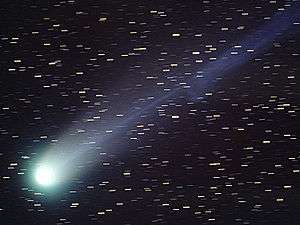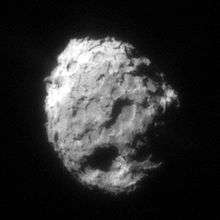51P/Harrington
| Discovery | |
|---|---|
| Discovered by | Robert G. Harrington at Palomar Observatory |
| Discovery date | 14 August 1953 |
| Orbital characteristics A | |
| Epoch |
2015-08-06 (JD 2457240.5) |
| Aphelion | 5.729 AU (Q) |
| Perihelion | 1.699 AU (q) |
| Semi-major axis | 3.714 AU (a) |
| Eccentricity | 0.5424 |
| Orbital period | 7.16 yr |
| Inclination | 5.42° |
| Last perihelion | 18 June 2008 |
| Next perihelion | 12 August 2015 |
51P/Harrington is a periodic comet in the Solar System.
It was discovered by Robert George Harrington at Palomar Observatory on 14 August 1953 using the Schmidt telescope. It then had a brightness of magnitude 15. In October 1956 its orbit was affected by the planet Jupiter and on its next return in 1960 the brightness had fallen to magnitude 20. By 1980 it had slightly improved to magnitude 18. It has a period of approximately 7 years.
In 1987 and 1994 brightness had significantly increased to magnitude 12. In 1994 Jim Scotti at Kitt Peak Observatory observed that the comet had broken up and that two detached pieces were accompanying the main body, which explained the improvement in the brightness. By 2001 further splitting had occurred.
See also
References
- Mobberley, Martin. Hunting and Imaging Comets. Google Books
External links
- Orbital simulation from JPL (Java) / Horizons Ephemeris
- 51P/Harrington – Seiichi Yoshida @ aerith.net
- Elements and Ephemeris for 51P/Harrington – Minor Planet Center
- 51P/Harrington at the Minor Planet Center's Database
- 51P/Harrington – Kazuo Kinoshita (2008 Dec. 21)
- 51P/Harrington – Gary W. Kronk's Cometography
| Numbered comets | ||
|---|---|---|
| Previous 50P/Arend |
51P/Harrington | Next 52P/Harrington–Abell |
This article is issued from Wikipedia - version of the 3/28/2016. The text is available under the Creative Commons Attribution/Share Alike but additional terms may apply for the media files.

